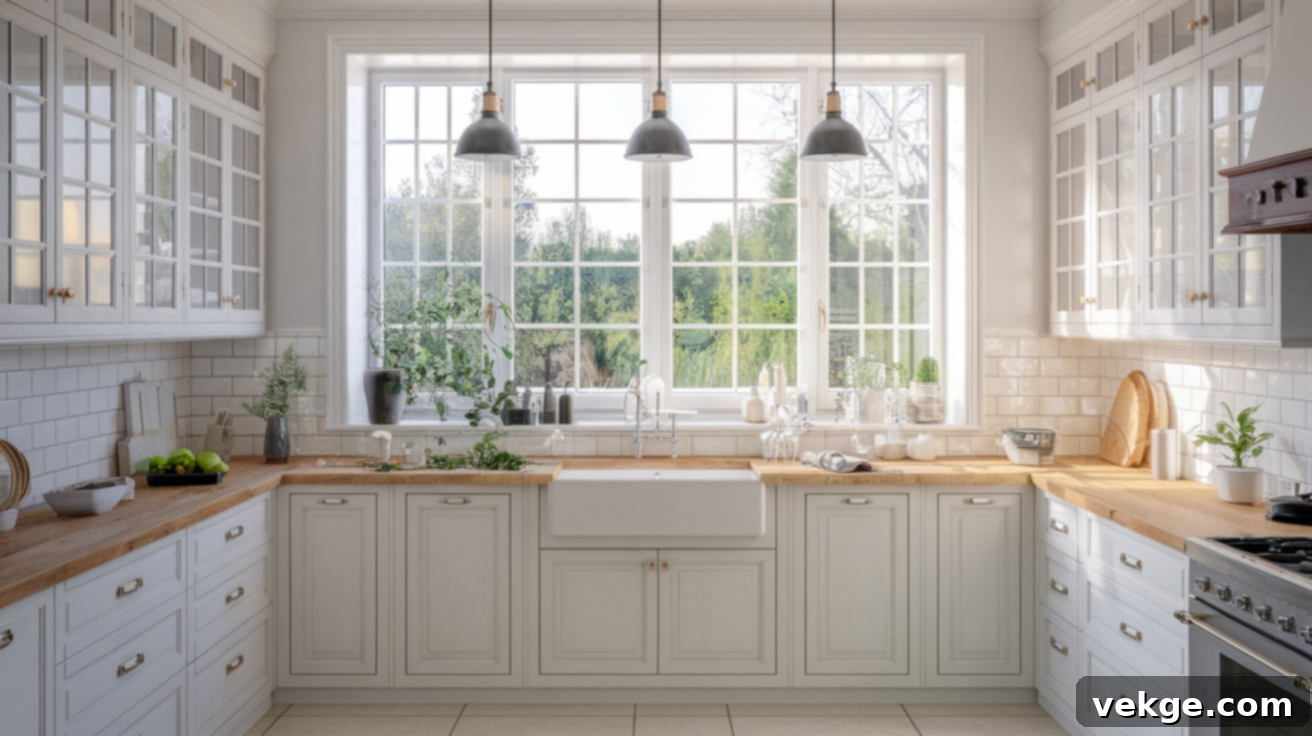Illuminate Your Kitchen: The Ultimate Guide to Lighting Above Your Sink with a Window
The kitchen sink is a central hub in most homes – a place where fruits are rinsed, dishes are scrubbed, and often, where we enjoy a moment gazing out a window while our hands are busy. Despite its vital role, this workspace frequently suffers from inadequate illumination, making daily tasks harder and the space less inviting. While a window naturally ushers in daylight, this natural light is often insufficient on its own, especially during the dim hours of early mornings, late evenings, or on gloomy, overcast days.
Effective lighting above your kitchen sink isn’t just about raw brightness; it’s about crafting a functional, comfortable, and visually appealing environment. Thoughtful lighting enhances safety by improving visibility, boosts efficiency for various tasks, and significantly contributes to the overall ambiance and warmth of your kitchen. Without the right light, your sink area can feel dim, dull, and even uninspiring, transforming what should be a pleasant activity into an avoidable chore.
This comprehensive guide is your essential resource to transform your kitchen sink area into a brilliantly lit, enjoyable space. We will explore the most effective types of artificial lighting solutions specifically tailored for sinks positioned under a window, delve into smart strategies for harmonizing these with natural light, and equip you with crucial tips to navigate and avoid common lighting pitfalls. From straightforward, elegant additions to sophisticated, layered setups, prepare to discover how to make your kitchen sink area not just functional, but truly radiant and welcoming.
Understanding Your Kitchen Sink Lighting Needs
Achieving optimal kitchen lighting extends far beyond simply installing a single overhead bulb. To truly maximize the functionality and appeal of your space, particularly around the hardworking sink area, you need a thoughtfully curated combination of light sources, each designated to fulfill a specific role. This layered approach ensures that every corner of your kitchen is adequately lit, flexible, and comfortable for various activities, day or night.
- Task Lighting: This is paramount for direct, focused illumination precisely where critical activities occur. Around the kitchen sink, task lighting ensures you have clear visibility for detailed tasks such as chopping vegetables, thoroughly scrubbing pots, or accurately reading recipe instructions. It effectively minimizes unwanted shadows and significantly reduces eye strain, thereby making daily chores more efficient, safer, and more enjoyable.
- Ambient Lighting: Also known as general lighting, ambient light provides a uniform, overarching glow that evenly fills the entire room. Its primary function is to facilitate safe movement throughout the kitchen and to eliminate dark, uninviting corners, thereby contributing to the overall brightness and inviting feel of your space. It serves as the foundational layer upon which all other lighting layers are built, setting the room’s base mood.
- Accent Lighting: Specifically designed to highlight and draw attention to particular features, accent lighting adds depth, style, and visual interest to your kitchen. In the vicinity of the sink, this could mean subtly illuminating a beautiful tile backsplash, showcasing decorative open shelving, or even turning the sink area itself into a striking focal point. It injects a touch of drama and elegance, beautifully underscoring your kitchen’s unique character and design elements.
By thoughtfully integrating these three fundamental types of lighting – task, ambient, and accent – your kitchen, especially the area surrounding your windowed sink, will transcend into a space that is not only highly functional and practical but also exceptionally aesthetically pleasing and supremely comfortable at any time. This strategic layering is the definitive key to creating a truly complete, versatile, and inviting kitchen environment.
Window Direction and Natural Light Maximization Tips
The orientation of your kitchen window significantly influences the quality and quantity of natural light that graces your sink area. Comprehending these natural light patterns is crucial for effectively complementing daylight with artificial lighting solutions, ensuring a consistent and pleasant environment throughout the day.
- East-facing windows: Usher in a soft, gentle, and often warm glow during the morning hours. This illumination is perfect for starting your day with natural light during breakfast preparation. However, this light fades as the day progresses, necessitating more supplementary artificial light in the late afternoon and evening.
- West-facing windows: Deliver bright, often intense sunlight in the afternoon and evening. While undeniably beautiful, this strong light can sometimes cause uncomfortable glare, particularly when the sun is low in the sky. This might call for the strategic use of dimmers for artificial lights or the implementation of window treatments during peak sun hours to manage brightness.
- North-facing windows: Provide a consistent, cooler, and more diffused light throughout the majority of the day, notably without direct sun exposure. This steady, shadow-minimizing illumination is excellent for tasks. However, it typically requires more supplementary artificial light compared to south or west-facing windows to maintain overall brightness.
- South-facing windows: Bathe the space in bright, warm, and often intense light for nearly the entire day. This abundant light can make your kitchen feel vibrant, spacious, and energetic. Nevertheless, it may also require thoughtful artificial lighting strategies to avoid overpowering the natural brilliance or to provide a softer, more ambient glow as evening approaches.
To fully capitalize on natural daylight, irrespective of your window’s orientation, consider these insightful tips. Strategically placing mirrors on a wall directly opposite your window can cleverly reflect and bounce sunlight deeper into the room, effectively amplifying its reach and brightening previously darker corners. Furthermore, opting for sheer curtains, blinds, or even smart films can help to soften harsh, direct sunlight, significantly reducing glare while still permitting a pleasant amount of diffused light to filter through, preserving privacy without sacrificing invaluable natural illumination. These simple additions can dramatically enhance your kitchen’s natural brightness and comfort.
Top Lighting Ideas Over the Sink With a Window
Selecting the perfect lighting fixture for your kitchen sink, especially when it’s beautifully framed by a window, demands a harmonious blend of functionality and impeccable style. The primary objective is to enhance daily kitchen tasks while simultaneously contributing to the overarching comfort and aesthetic allure of your entire kitchen space. The right lighting can effortlessly transition your sink area from a brightly lit, focused workspace during meal preparation to a softly illuminated, inviting spot for evening cleanup or quiet contemplation. Below, we delve into a diverse array of practical and stylish lighting solutions, meticulously chosen to complement various kitchen layouts, aesthetic preferences, and specific illumination requirements.
1. Pendant Lights
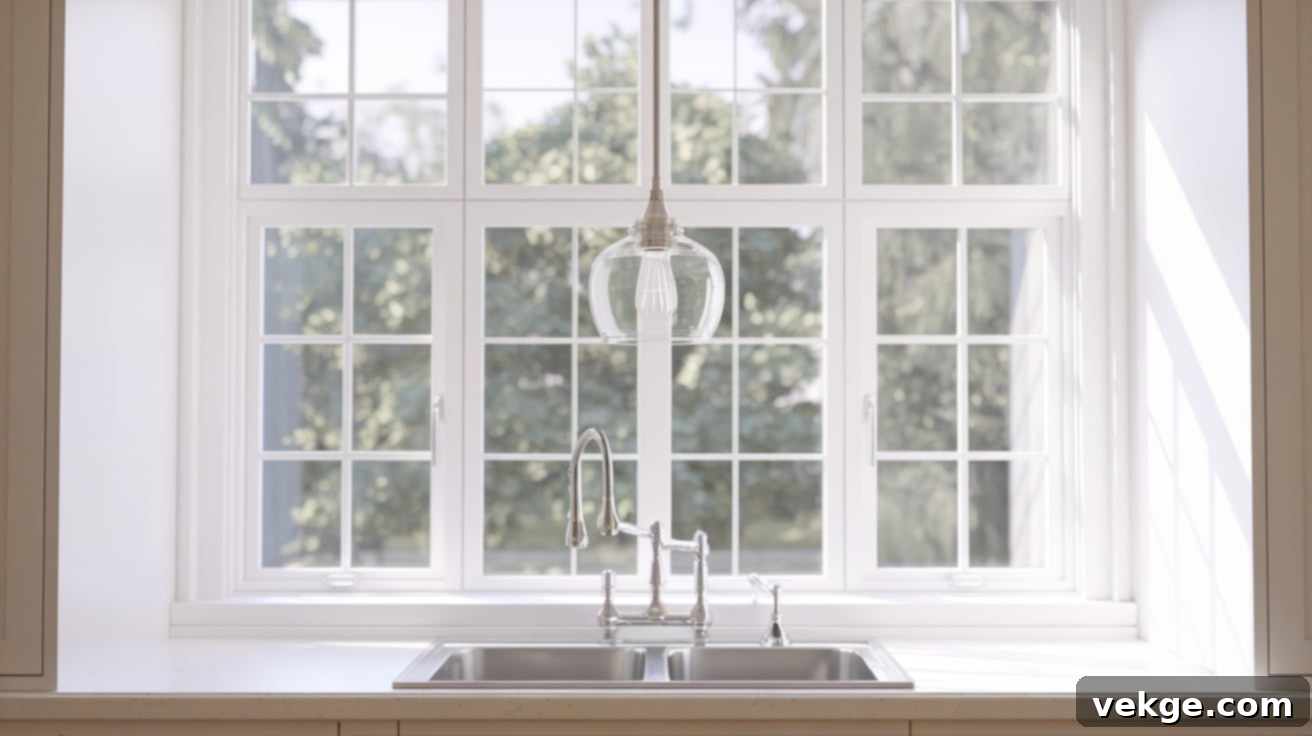
Pendant lights remain an enduringly popular choice for illuminating the kitchen sink, and for excellent reasons. Suspended gracefully from the ceiling by a sleek rod or an elegant chain, they deliver a highly focused downlight precisely where you need it most, making tasks like washing dishes, scrubbing vegetables, or simply wiping down the counter much easier and more efficient. Beyond their inherent functionality, pendants offer incredible versatility in design, available in a vast array of styles, materials, and finishes—from industrial chic to rustic farmhouse or sleek modern—to perfectly complement any kitchen aesthetic.
For optimal placement and functionality, a good rule of thumb is to position pendant lights approximately 30–36 inches above the countertop. This height ensures they provide ample illumination without obstructing your view out the window or interfering with head clearance. To achieve a balanced visual appeal and prevent them from feeling too crowded against the window frame, aim for a placement 6–12 inches away from the window’s edge. Choosing a pendant with a shade designed to direct light primarily downwards is crucial for effective task illumination. While clear or frosted glass shades allow for a broader, more diffused spread of light, metal or opaque shades are excellent for concentrating light and minimizing glare, a valuable feature in brightly lit kitchens or areas with reflective surfaces. Consider the bulb type as well; LEDs offer energy efficiency and a range of color temperatures to match your desired ambiance.
2. Mini Chandeliers
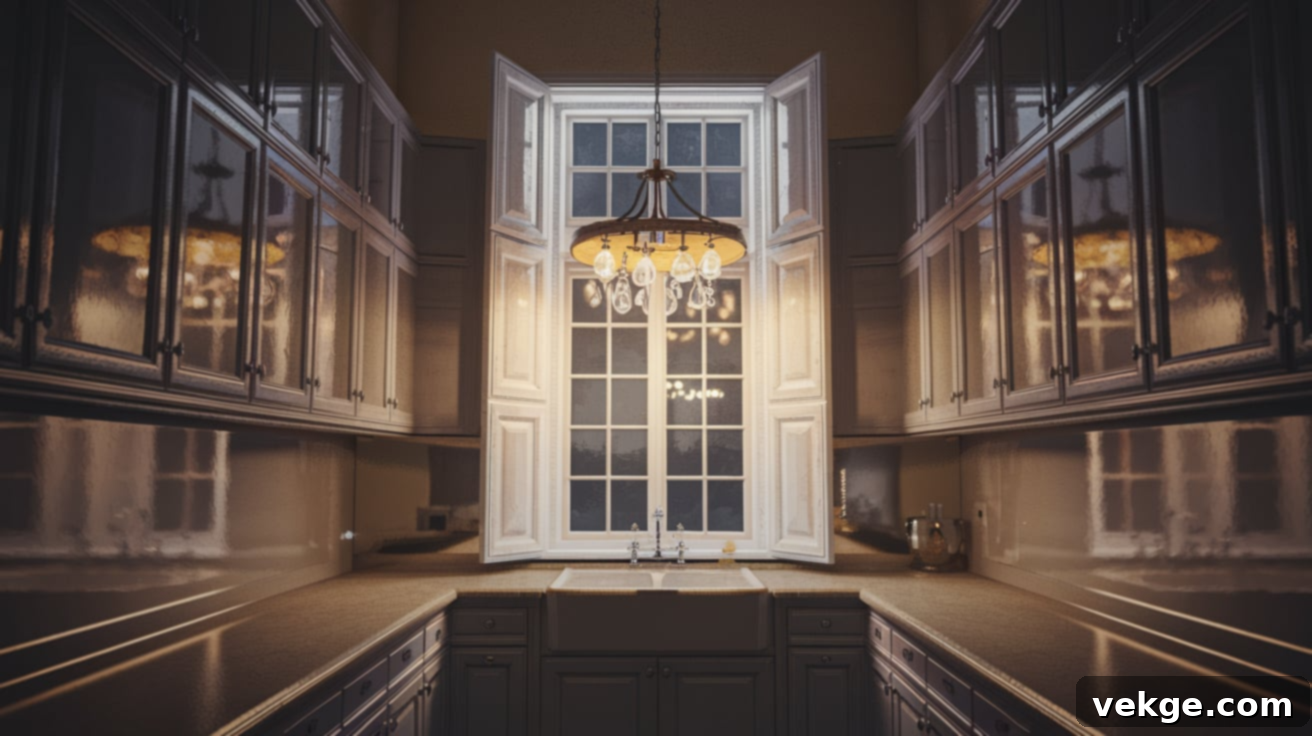
For kitchens graced with higher ceilings or those seeking to infuse a touch of sophisticated charm and elegance above the sink, mini chandeliers present a delightful and refined alternative. These smaller-scale chandeliers are perfectly designed to fill vertical space beautifully, adding visual interest without overpowering the area. They introduce a distinct sense of grandeur and softness, effortlessly transforming the practical sink space into a decorative focal point that captures attention. To maintain a cohesive and harmonious look, and to prevent the area from feeling overly busy or cluttered, it’s advisable to opt for simpler, understated designs that gracefully complement your existing kitchen decor rather than competing with it.
It is paramount to ensure that the mini chandelier is appropriately scaled, not only to the size of your window but also to the overall dimensions and ceiling height of your kitchen. A fixture that is disproportionately large can visually shrink the window and create an overwhelming presence, whereas one that is too diminutive might get lost in the space, failing to make the desired impact. Always give careful consideration to the hanging height; it should be sufficiently high to provide ample head clearance and ensure it doesn’t obstruct the cherished view from your window. Generally, following similar guidelines to pendant lights—about 30–36 inches above the counter—will ensure it enhances the space with both grace and illumination, turning your sink area into a true design statement.
3. Under-Cabinet Lighting
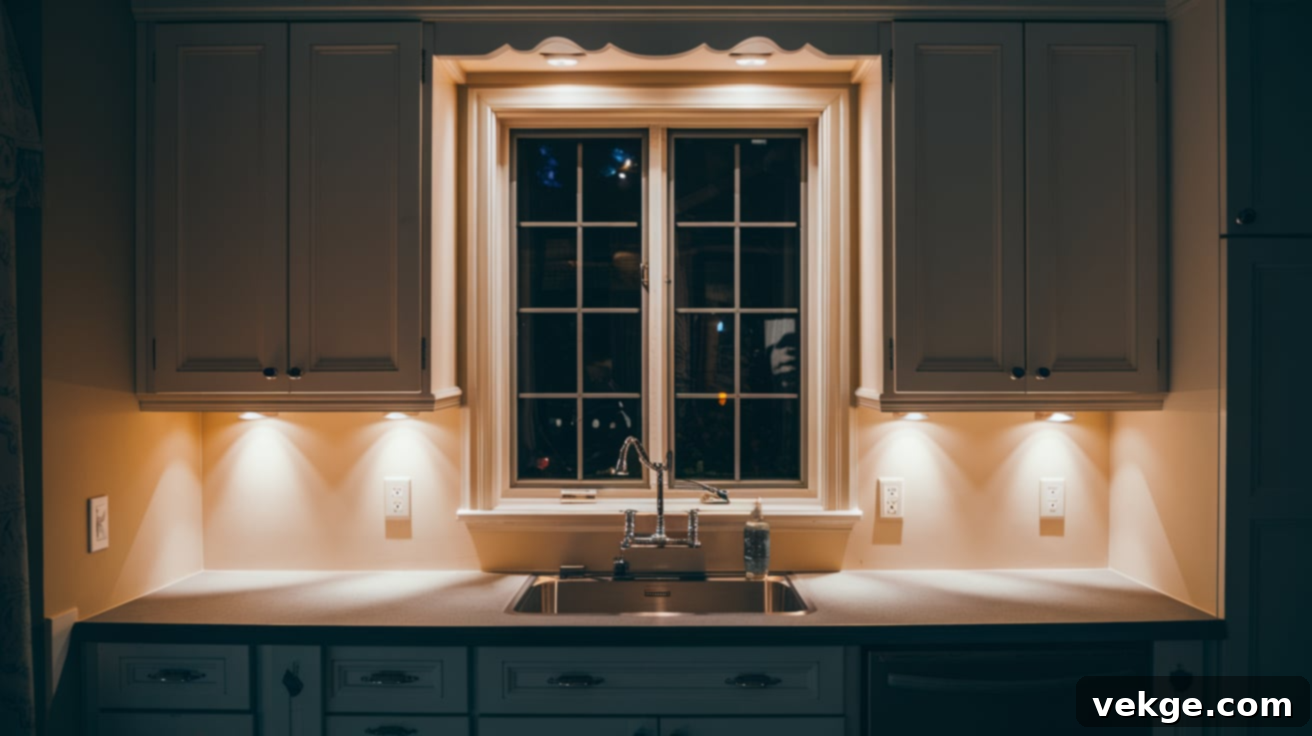
If your kitchen sink is thoughtfully positioned beneath an overhead cabinet or a structural soffit, under-cabinet lighting emerges as an incredibly effective, discreet, and highly functional illumination solution. These lights are ingeniously mounted directly on the underside of the cabinetry, providing a focused, direct beam of light precisely onto the sink area. This strategic placement expertly eliminates common dark spots and bothersome shadows that often plague sink workspaces, significantly enhancing visibility for critical tasks such as washing dishes, meticulously scrubbing produce, or performing delicate food preparation.
Contemporary options such as slim, energy-efficient LED light bars or compact LED puck lights are perfectly suited for this application. They are celebrated for their long lifespan, minimal heat emission, and superior energy efficiency. Installation is typically straightforward, making them a popular and accessible choice for both ambitious new kitchen builds and thoughtful remodeling projects. Many advanced systems also offer the capability for seamless linking with other under-cabinet lights throughout your kitchen, ensuring a consistent and comprehensive task lighting scheme across all work surfaces. This integrated approach guarantees that every inch of your countertop and sink area receives bright, even, and shadow-free illumination exactly when and where you need it most, dramatically improving both the utility and safety of your kitchen.
4. LED Strip Lighting
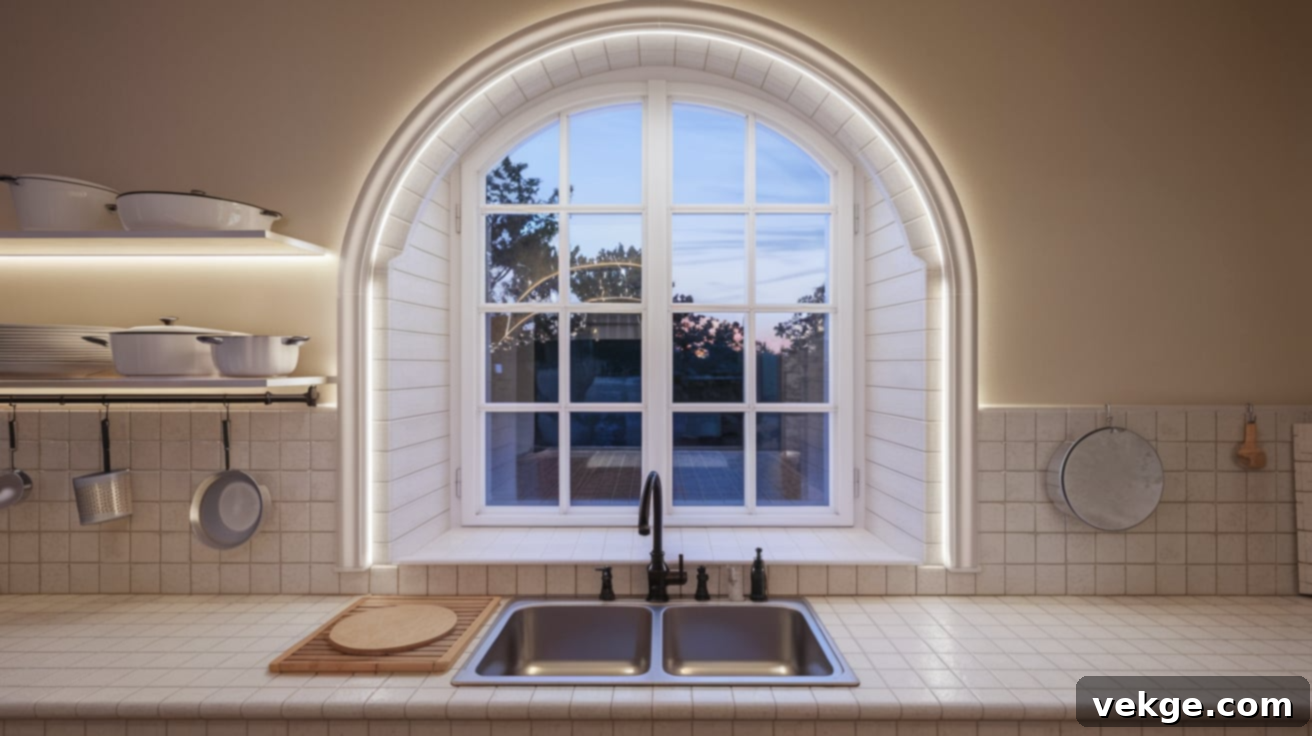
For a truly contemporary, versatile, and unobtrusive lighting solution, LED strip lights are an outstanding choice for the kitchen sink area. These remarkably flexible, low-profile strips can be discreetly installed in a multitude of locations – tucked away under cabinets, elegantly lining open shelves, or even artfully tracing the perimeter of the window trim itself – to deliver a soft, steady, and wonderfully uniform glow. They are exceptionally effective for creating ambient lighting, offering a pleasant and inviting backdrop when natural light begins to diminish, and can also serve as impactful accent lighting to subtly define architectural features or cultivate a cozy, intimate atmosphere.
When selecting LED strip lights, it’s advisable to choose a warm or neutral color temperature (typically measured in Kelvin) to ensure the light feels inviting and blends harmoniously with any existing natural light. A range of 2700K to 4000K often works best to avoid a harsh or overly cold feel. Many modern LED strips come equipped with integrated dimmers or are fully compatible with external dimmer switches, offering unparalleled flexibility to precisely adjust the brightness to suit any mood, task, or time of day. Their remarkable ease of installation, superior energy efficiency, and inherent ability to conform to various surfaces make them an incredibly popular and highly practical option for crafting a truly personalized and dynamic lighting scheme in your kitchen.
5. Wall Sconces
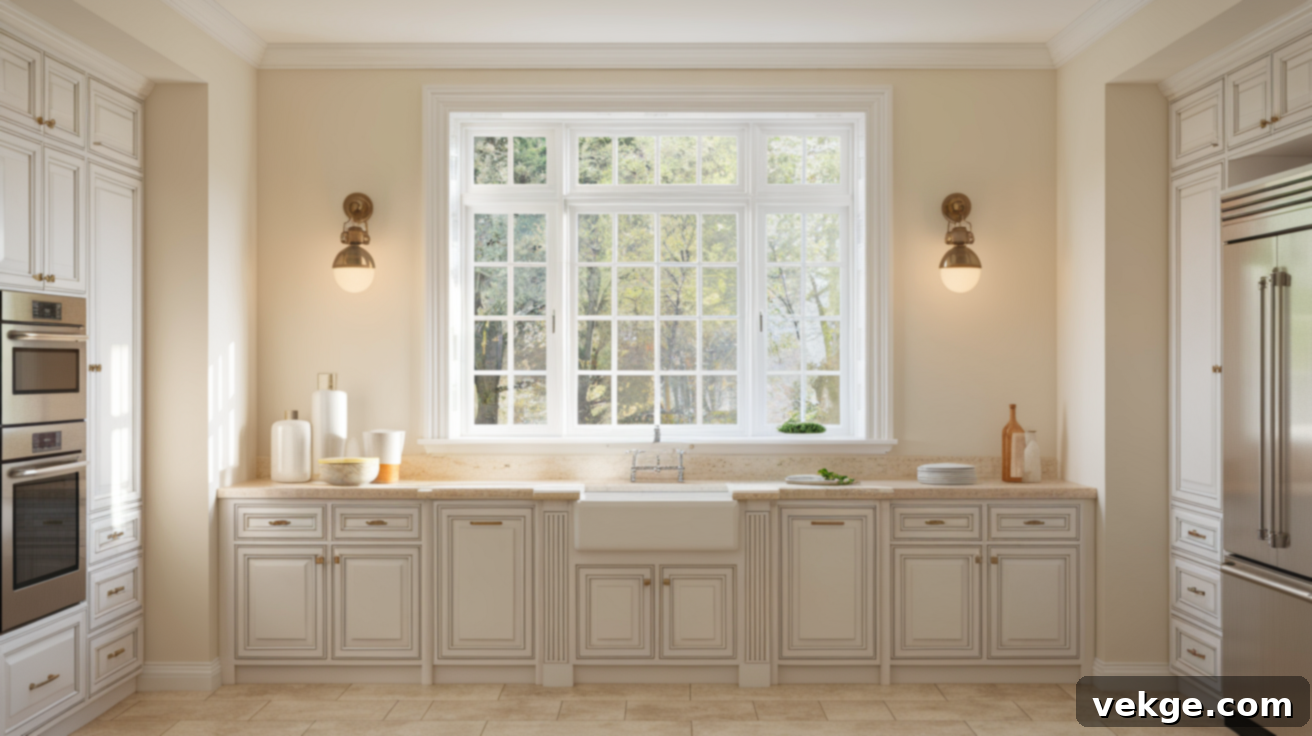
Wall sconces offer a classic, elegant, and uniquely charming approach to illuminating the kitchen sink, particularly when they are strategically positioned on either side of a window. This symmetrical placement not only casts an even, flattering light across the entire sink area but also introduces a powerful element of visual balance, architectural interest, and sophisticated design to the wall. Sconces typically provide a more diffused and often softer light compared to direct overhead fixtures, creating a wonderfully ambient and welcoming atmosphere that can be exceptionally appealing and comforting.
Available in an expansive array of styles—ranging from sleek, minimalist metal designs to more traditional shaded or intricate fixtures—sconces can effortlessly complement and enhance the existing aesthetic of your kitchen, be it modern, transitional, or classic. When making your selection, it’s crucial to carefully consider the scale of the fixture in relation to your window and the available wall space. If wall space is at a premium, opting for smaller, more streamlined designs will prevent the area from feeling overcrowded or visually heavy. Always ensure the light source is directed appropriately to minimize glare while still providing sufficient and effective illumination for your daily tasks. Wall sconces are a superb choice for adding both essential functional light and significant decorative flair, elevating the design of your kitchen sink area.
6. Recessed Lighting
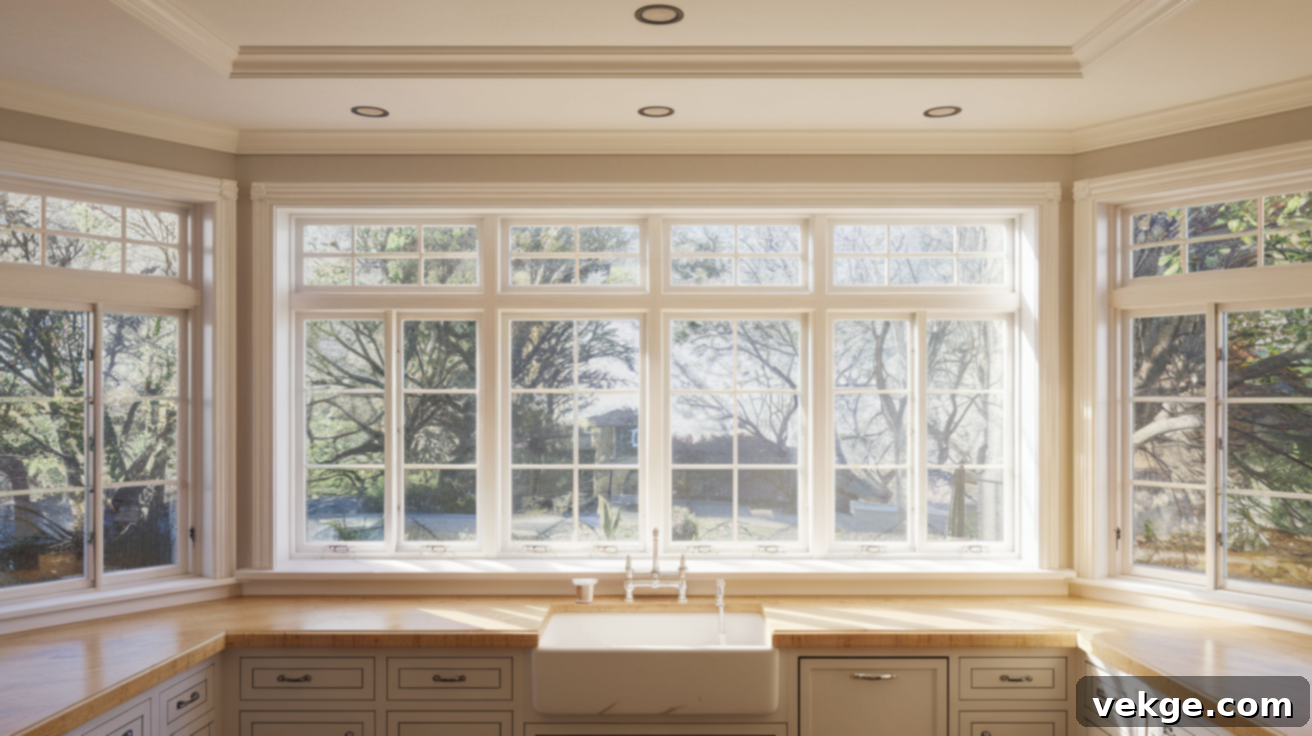
For homeowners who cherish a clean, uncluttered, and minimalist ceiling aesthetic, recessed lighting stands out as an excellent and highly versatile choice. These fixtures are ingeniously installed flush with the ceiling, offering powerful and effective illumination without visually intruding on your space or design scheme. A strategically placed recessed light (or two, depending on the dimensions of your sink and window) directly above the sink can provide ample task lighting while maintaining that desired sleek, minimalist look. This approach is particularly advantageous in smaller kitchens or in rooms where hanging fixtures might feel overwhelming, obstructive, or could potentially block the cherished view from the window.
Recessed lights are exceptionally effective for providing general ambient lighting, but with the correct beam spread and precise placement, they can also serve as highly focused task lights. Many contemporary recessed lights are LED-based, offering superior energy efficiency, impressive longevity, and a variety of color temperatures. The invaluable addition of a dimmer switch allows for complete and precise control over brightness, enabling you to effortlessly adjust the light from a full-beam task illumination to a softer, more ambient glow as needed throughout the day and evening. This remarkable adaptability makes them a practical, versatile, and future-proof lighting choice for any kitchen sink area, blending seamlessly into modern design palettes.
7. Track Lighting
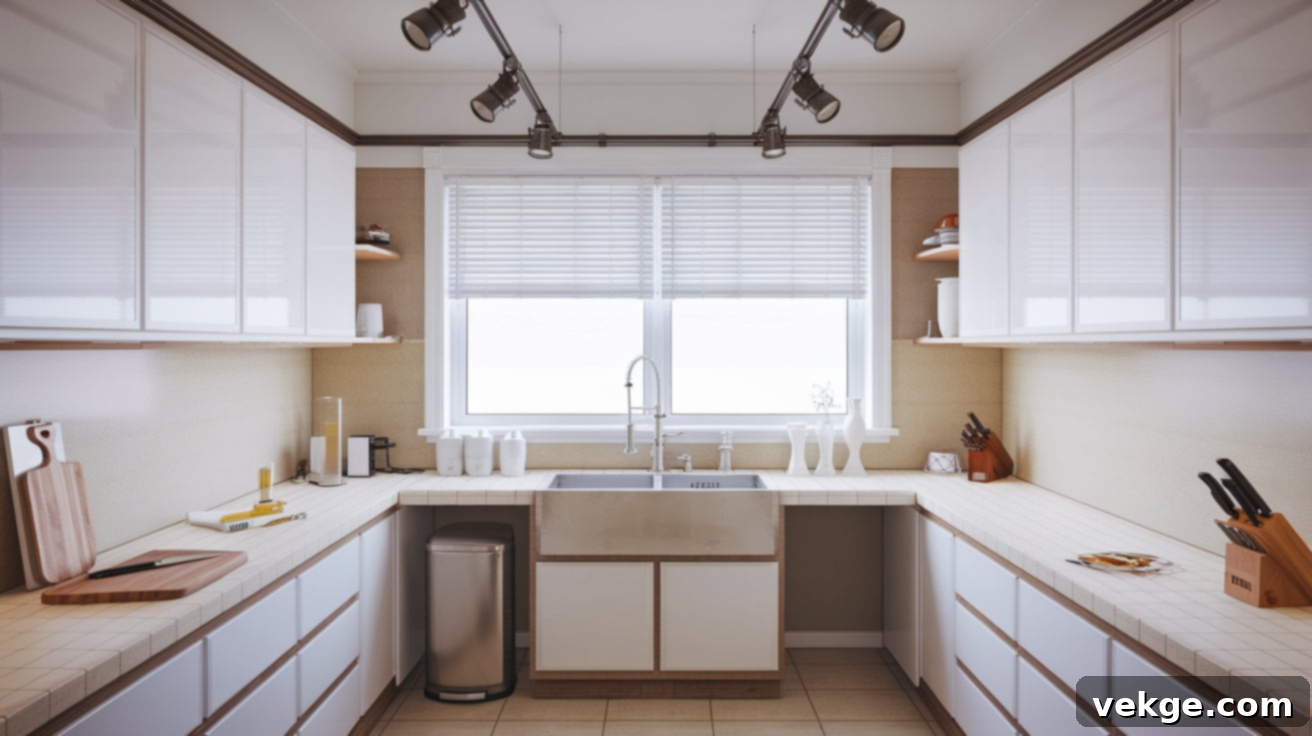
Track lighting offers unparalleled flexibility and adaptability, making it an ideal solution for kitchen sinks that are part of a larger, more active workspace or in kitchens where lighting requirements may frequently evolve. This innovative system consists of multiple adjustable light heads mounted on a continuous rail or track, allowing you to direct light precisely where it’s needed most. You can individually aim each head to brilliantly illuminate the sink, provide focused light on adjacent countertops, or even artfully highlight decorative elements such as nearby open shelves or cherished artwork. This remarkable adaptability is truly invaluable in dynamic kitchen environments where tasks and moods shift.
Modern track lighting designs have undergone significant evolution, moving far beyond bulky, industrial aesthetics to embrace sleek, slim profiles that integrate seamlessly into contemporary kitchen decor. When selecting track lighting, look for systems with a minimalist aesthetic and energy-efficient LED heads for both style and sustainability. The inherent beauty of track lighting lies in its inherent versatility; you can effortlessly reposition, add, or even remove light heads as your specific needs evolve, making it a truly future-proof and adaptable lighting investment. It stands out as a particularly smart option for kitchens that demand highly versatile illumination for a wide range of tasks and atmospheres.
8. Glass or Globe Lights
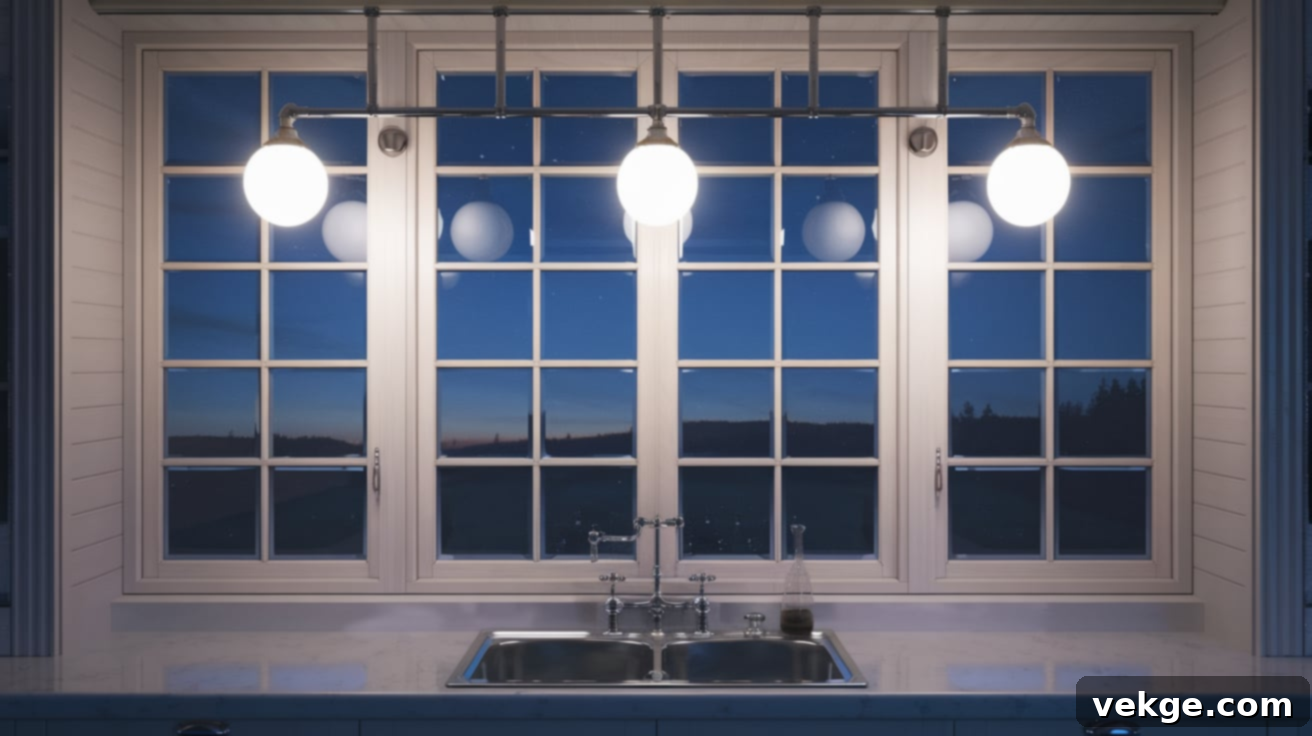
For those seeking a soft, widespread, and beautifully diffused illumination that wonderfully complements natural daylight, glass or globe light fixtures are an excellent and elegant choice. These fixtures, often featuring clear, frosted, or opal glass, are meticulously designed to diffuse light evenly across an entire area, effectively reducing harsh shadows and creating a gentle, inviting glow. They can be gracefully mounted on the ceiling directly above the sink or, depending on the specific architectural nuances, even from a sturdy window ledge or a tastefully built soffit positioned just above the window.
The inherent transparency or translucency of glass shades plays a crucial role in spreading light effectively, making them ideal for brightening the overall sink area without generating concentrated hotspots or glare. They integrate particularly well in kitchens that aim for a light, airy, minimalist, or Scandinavian-inspired aesthetic. When selecting a glass or globe fixture, it’s vital to pay close attention to its size and scale in relation to your window and the surrounding spatial dimensions. A well-proportioned fixture will subtly enhance the area, offering both essential functional light and a touch of understated elegance that blends seamlessly and beautifully with the natural light streaming in from your window, creating a harmonious and luminous atmosphere.
9. Layered Lighting (Mix and Match)

The most sophisticated, effective, and truly versatile lighting scheme for a kitchen sink that is accompanied by a window often involves a meticulously planned layered approach. This strategy combines multiple types of lighting to achieve an optimal balance of functionality, ambiance, and adaptability. Layered lighting means strategically integrating task, ambient, and accent lights to construct a dynamic, adaptable, and highly responsive lighting environment, ensuring your kitchen is perfectly illuminated for any activity, at any moment of the day or night.
For example, you might effectively utilize recessed lights for broad, general ambient brightness spread across the kitchen ceiling. Complementing this, a stylish pendant light could be installed directly above the sink for dedicated, focused task illumination, while discreet under-cabinet lighting or LED strips along the backsplash provide additional task support, eliminate shadows, and serve as subtle accent lighting. This highly versatile setup grants you the invaluable flexibility to precisely activate only the amount and type of light you need for any given situation. It guarantees that the sink area remains consistently well-lit and comfortable during all hours, which is especially crucial when natural light from the window is scarce, allowing your kitchen to transition effortlessly from a bright, efficient morning workspace to a warm, inviting, and intimate evening hub.
Combining Natural and Artificial Lighting for Optimal Kitchen Sink Illumination
The presence of a window above your kitchen sink is an undeniable asset, gracing your space with invaluable natural daylight. However, relying exclusively on sunlight is rarely sufficient for a truly functional and comfortable kitchen. A truly effective kitchen lighting strategy masterfully harmonizes natural light with carefully chosen artificial sources, ensuring a consistently bright, highly functional, and aesthetically pleasing environment regardless of the time of day or prevailing weather conditions. The ultimate objective is to forge a seamless transition and cultivate a comfortable, balanced glow that simultaneously enhances both the utility and the overall mood of your kitchen.
To elegantly achieve this harmony, begin by meticulously considering the color temperature (CCT) of your artificial lights. Natural daylight typically falls within the “cool white” to “daylight” spectrum (ranging approximately from 4000K to 6500K), though the light at dawn and dusk can exhibit warmer tones. Aim to closely match the color temperature of your electric bulbs to thoughtfully complement this natural light. Employing bulbs in the 3500K-4500K range (neutral white to cool white) can help maintain a consistent and unified feel, especially if your window receives an abundance of bright, direct sunlight. Critically, avoid drastic mixtures of very warm (yellowish) and very cool (bluish) lights, as this can create an uneven, disjointed, and visually jarring atmosphere within the room, making it feel less cohesive and less inviting.
Furthermore, distributing light from various angles is absolutely key to effectively eliminating harsh shadows and ensuring comprehensive illumination around the sink area. Instead of solely depending on a single overhead fixture, integrate multiple light sources to cast light from different directions. This multi-point approach is particularly potent for reducing bothersome shadows that frequently occur when you’re leaning over the sink for tasks such as washing dishes or engaging in intricate food preparation. Consider a strategic combination of the following:
- Overhead recessed lights or a central ceiling fixture to provide broad, general ambient brightness across the entire kitchen space.
- Under-cabinet or LED strip lights, expertly installed beneath any upper cabinets framing the sink, offering direct, shadow-free illumination precisely for close-up tasks.
- Wall sconces positioned elegantly on either side of the window, or a tastefully chosen pendant light hanging centrally above the sink, to provide focused task lighting and evenly distribute light from the sides, thereby preventing a ‘cave-like’ or overly dark effect.
If your window frequently receives strong, direct afternoon sun, the installation of dimmer switches for your artificial lights is highly recommended and incredibly beneficial. Dimmers offer invaluable flexibility, empowering you to precisely fine-tune the brightness of your indoor lighting to perfectly balance with the intensity of the natural light streaming through the window. This intelligent control prevents the area from becoming over-illuminated or glaring during peak sun hours and allows for a softer, more ambient setting as dusk gently approaches. A thoughtfully orchestrated blend of natural sunlight and carefully chosen indoor lighting will undeniably make your kitchen sink area a pleasure to use, significantly enhancing both its practicality and its inviting atmosphere throughout every hour of the day.
Common Kitchen Sink Lighting Mistakes to Avoid
While meticulously planning your kitchen sink lighting, being acutely aware of common pitfalls can save you considerable time, money, and frustration in the long run. The sink area is a unique and often demanding zone, frequently subjected to splashes, steam, varying light conditions, and potential grease buildup. Actively avoiding these prevalent mistakes will ensure that your chosen lighting solution is not only visually stunning but also supremely practical, durable, and highly functional for years to come.
- Neglecting Ease of Cleaning: The environment around the kitchen sink is inherently prone to splashes, condensation, and the occasional accumulation of grease. Opting for intricate fixtures with numerous small parts, delicate finishes, or porous materials can quickly lead to unsightly grime buildup and make regular cleaning a laborious chore. Instead, prioritize smooth, easily wipeable surfaces such as glass, sealed metal, or robust coated finishes that are specifically designed to withstand moisture, steam, and daily kitchen messes. Routine, gentle cleaning with a soft, non-abrasive cloth will effortlessly keep your fixtures sparkling; always avoid harsh chemicals or abrasive scrubbing materials that can irrevocably damage finishes.
- Improper Fixture Placement: A remarkably frequent mistake is the incorrect placement of lights—either too high or too low—above the sink. Lights mounted excessively high tend to scatter light broadly across the ceiling but fail to adequately illuminate the direct sink area, thereby creating frustrating shadows over your primary workspace. Conversely, fixtures hung too low can obstruct your view out the window, feel visually intrusive, or even pose a minor hazard for taller individuals. Aim for a comfortable and functional height, generally between 30-36 inches above the countertop, ensuring focused, effective light without any visual obstruction or inconvenience.
- Incorrect Bulb Color Temperature: The choice of light bulb color temperature (CCT) can dramatically impact the comfort, utility, and overall mood of your sink area. Utilizing light bulbs that are either too cool (producing a bluish hue) or too warm (emitting an excessively yellowish hue) can make tasks uncomfortable and distort the true colors of food. Overly cool lights can create a stark, clinical, and unwelcoming ambiance, while excessively warm lights might make detailed tasks harder by making everything appear dim or inaccurately colored. Strive for a balanced color temperature typically between 3000K and 4000K (ranging from soft white to neutral white) for a comfortable, inviting, and true-to-color illumination that perfectly complements natural daylight.
- Ignoring Glare and Reflections: Kitchens are often adorned with reflective surfaces such as stainless steel sinks, polished stone countertops, or glossy backsplashes. Placing light fixtures directly opposite or too close to these surfaces without careful consideration can result in annoying and dazzling glare, making it difficult to see what you’re doing and causing significant eye strain. To mitigate reflections, choose fixtures equipped with diffusers, frosted glass, or those that offer directional light, allowing you to angle the light away from highly reflective surfaces. Alternatively, consider incorporating indirect lighting sources that bounce light off ceilings or walls to provide a softer, more diffused glow.
- Disregarding Natural Light Interaction: While artificial light is absolutely essential, overlooking how it interacts with your window’s natural light throughout the day is a critical oversight that can lead to an uneven and sometimes uncomfortable lighting experience. A meticulously planned artificial lighting scheme that appears fantastic at night might clash severely with the morning sun, or conversely, fail to adequately compensate for a gloomy, overcast afternoon. To achieve a harmonious environment from dawn till dusk, it is crucial to incorporate dimmers for artificial lights and to select fixtures and bulbs that blend seamlessly with the color and intensity of the ever-changing natural light.
Conclusion: Brighten Your Kitchen Sink with the Perfect Lighting
Finding the ideal lighting solution for your kitchen sink, especially when it beautifully features a window, is a meaningful investment in both the inherent functionality and the enduring aesthetics of your home. This comprehensive guide has thoughtfully illuminated how various lighting styles—ranging from the practical efficiency of pendants to the elegant charm of sconces and the versatile sophistication of layered setups—can profoundly transform your kitchen workspace. We’ve meticulously explored the art of seamlessly combining the natural light streaming in from your window with strategically chosen artificial illumination to create a balanced, inviting, and supremely efficient environment, perfectly suited for any time of day or night.
You are now equipped with invaluable knowledge to precisely understand your specific lighting needs, confidently identify the best fixtures tailored for your unique setup, and skillfully integrate them with the dynamics of natural daylight. Moreover, you are now prepared to adeptly sidestep common lighting mistakes that could otherwise detract from your kitchen’s overall appeal and crucial functionality. From ensuring effortless ease of cleaning to selecting the perfect color temperature and meticulously avoiding unwanted glare, every detailed consideration contributes to an undeniably superior and delightful lighting experience.
The right illumination elevates your kitchen sink area beyond merely a place for chores; it transforms into a comfortable and efficient spot for daily tasks, a brightly invigorated space for morning routines, and a warm, inviting corner for evening wind-downs and contemplative moments. If you are contemplating an update, we encourage you to begin by thoroughly assessing what truly fits your space, personal style, and daily habits best. Then, with newfound confidence, build a lighting scheme that brings your vision to vibrant life.
For even more inspiration, expert advice, and innovative ideas on enhancing your home’s lighting and overall design, be sure to explore our other comprehensive guides. Let your kitchen truly shine in every sense!
